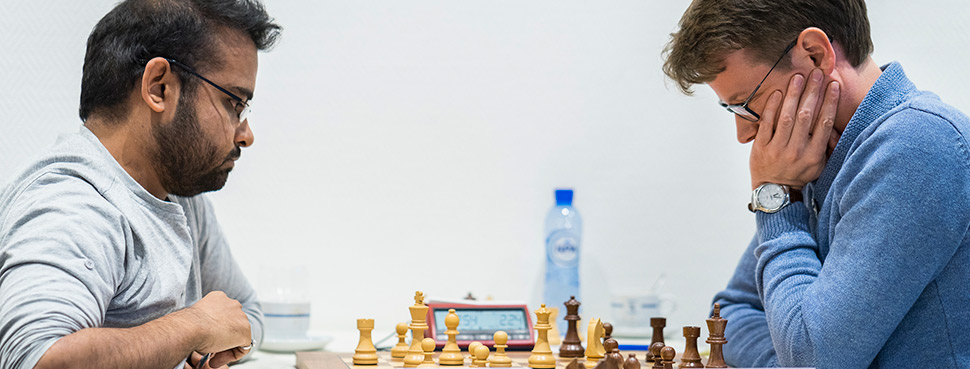It’s starting to look like a TTT in the Open: the Indian titled players keep alternating and are thundering on. Most of the leading work is done by Babu Lalith an Abhijeet Gupta. They are still on 100%, but their fellow countrymen S.Nitin and Sundar Shyam are trailing by only half a point. The first Dutch players are in the next group with three points. Among them are, quite surprisingly, Dick de Graaf and Sander Taams – the player with the lowest rating!
Gupta faced a furiously attacking Jan Werle today.
Gupta - Werle
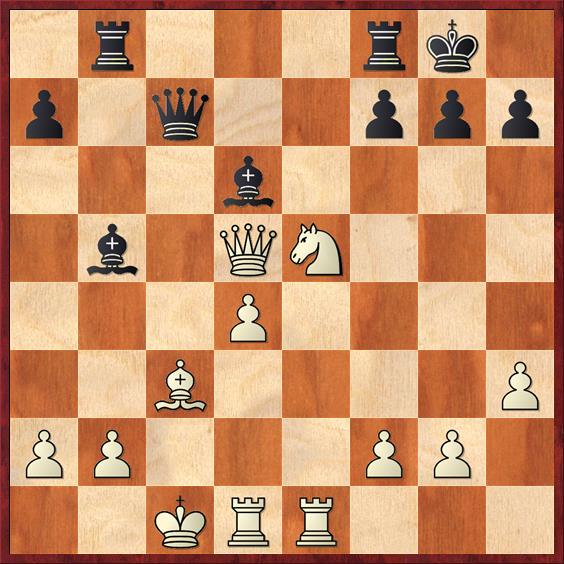
Werle has spent two pawns, and now goes over to the attack.
20...Ba3!? 21.Qb3 Bxb2+?!
Unfortunately this is one step too far. It comes down to a sacrifice of the ‘small exchange’, and Werle is hoping that the permanent vulnerability of the white king will offer him enough attacking chances.
Strangely enough, 21...Bd6! was still fine for Black here. After 22.Qc2 he can play 22...f6, followed by either 23...Qc6 or 23...Bc4, with great compensation.
22.Qxb2 Ba4 23.Qa3 Bxd1 24.Rxd1 Rfc8 25.Kd2 f6 26.Nd3 Qc4 27.Rc1 Qd5 28.Nf4 Qf5 29.Qd6! Kh8 30.g3
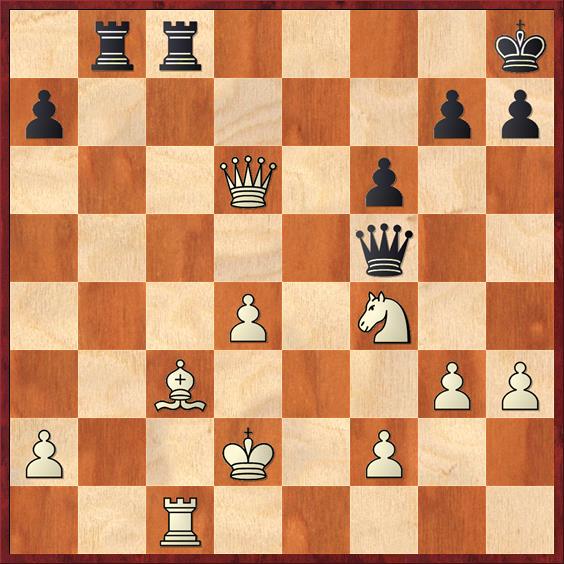
And the white position proved unassailable. On move 39 Werle ceased his attempts: 1-0.
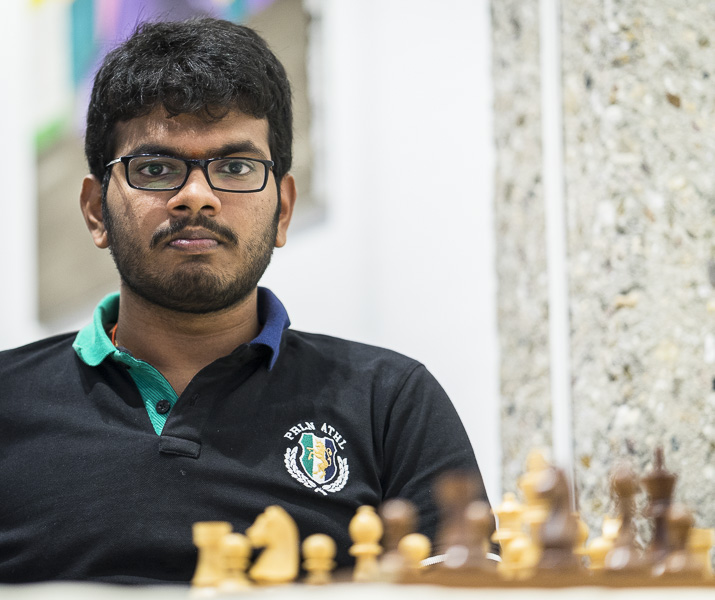
Lalith. Foto: Lennart Ootes
Lalith overcame his fellow countryman and co-leader Rathnakaran in a King’s Indian.
Lalith - Rathnakaran
1.Nf3 Pf6 2.c4 g6 3.Nc3 Bg7 4.d4 0–0 5.e4 d6 6.h3 Na6 7.Bg5 c6 8.Be2 e5 9.d5 h6 10.Be3 cxd5 11.cxd5 Nh5 12.Qd2 Kh7

13.0–0
A quiet move. In this position, 13.g4 Nf4 14.Bxf4 exf4 15.Qxf4 was played three times, after which Black can actively search for compensation for the pawn.
13...f5?! 14.exf5 gxf5 15.Ne1
Again, quite cool play. 15.Nxe5 dxe5 16.Bxh5 f4 wouldn’t have been clever, but White could prepare this by 15.Qc2!.
15...Nf6 16.f4 Bd7
The hyper-active 16...Ne4!? 17.Nxe4 fxe4 18.fxe5 Rxf1+ 19.Bxf1 Bxe5 was interesting.
17.Nd3 Qe8
Black will lose this struggle on the e-file. 17...e4! looks like a better chance.
18.fxe5 dxe5 19.Rae1 Rg8

20.Nxe5! Ne4
The elegant point was 20...Qxe5 21.Bxa6 bxa6? 22.Bf4! and the queen has no squares! After 22...Ne4 23.Rxe4! White gets the piece back.
21.Nxe4 Bxe5 22.Nc3
And thus White had gained a pawn. He fended off the counterattack with a steady hand: 1–0 (35).
Sundar Shyam won a piece very early in the game against his fellow countryman Rakesh Kumar Jena. Casper Schoppen held his second grandmaster to a draw after good preparation: the strong Chanda Sandipan. With his trainer Dimitri Reinderman he came to the commentary room with Hans Böhm to explain the game.
We were eagerly awaiting the duel between the pupil, Lucas van Foreest, and his master, Sipke Ernst. They already played a match once in Groningen, which was convincingly won by Ernst, but Van Foreest has also beaten his trainer on another occasion. This time the game was quite lively.
L. van Foreest - Ernst
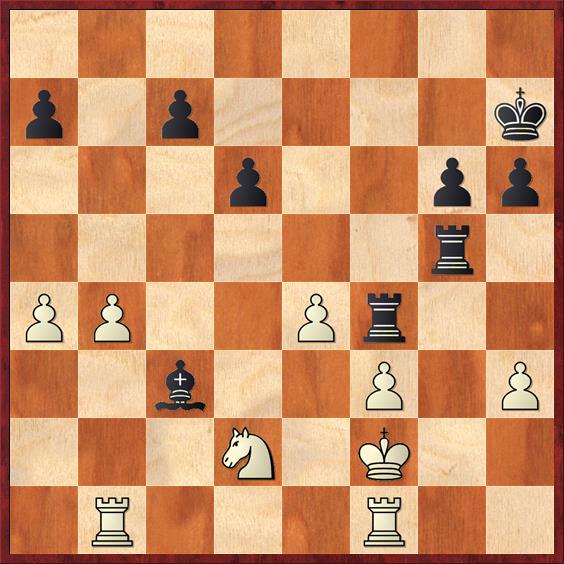
Van Foreest appeared to be slowly losing his grip on the game, but he stayed afloat with a smart trick:
31.Rfc1! Bxd2?!
31...Bd4+=.
32.Rxc7+ Kg8 33.Rb2

Bishop trapped!
33...Be1+ 34.Kxe1 Rxf3 35.Rf2
With 35.Rd2! he could have posed Black a few problems.
35...Re3+ 36.Kf1 Rxe4 37.Rc8+ Kg7 38.Rc7+ Kg8 39.Rc8+ ½–½

Sipke Ernst. Foto: Lennart Ootes
Han Schut, who had started well with 2 out of 3, started today by totally outplaying Thomas Beerdsen and winning an exchange. Then, however, he became careless and allowed a couple of beastly passed pawns, after which the expected result entered the books after all.
Dick de Graaf was also enjoying a nice tournament so far, and in this fourth round he even managed to catch a grandmaster unawares: Harmen Jonkman, who hasn’t played a lot recently, and is not performing very smoothly. And how did De Graaf win? He is mainly known as a tactician, but this time he got the better of his renowned opponent in an endgame.
De Graaf - Jonkman

Somewhere in this endgame, De Graaf offered a draw, but of course Jonkman declined. ‘When I got a beautiful knight on e3 I wasn’t prepared to accept a draw anymore’, said De Graaf.
30...Rb6?! 31.f5! gxf5?!
Splitting the white pawn structure, but, more importantly, the h6-pawn becomes irreparably weak.
32.gxf5 Bc8 33.Rh4 Kf6 34.Rxh6+ Ke5 35.Rh8 Rb2+
Not 35...Bxf5?? 36.Rh5.
36.Kf3 Bb7
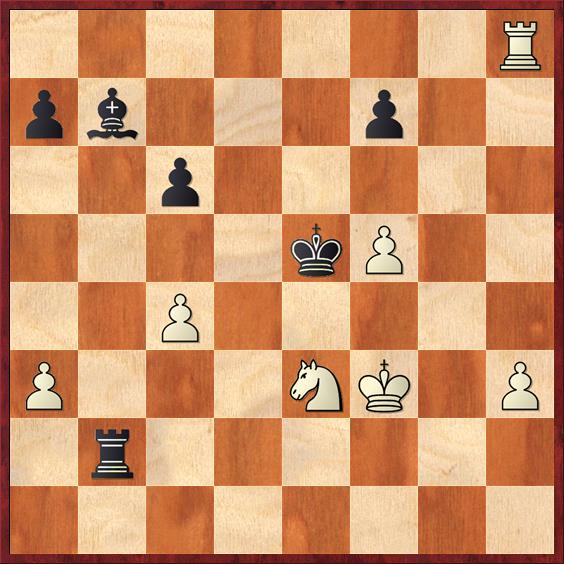
37.c5!
Even stronger was 37.Re8+ Kd4 (37...Kf6 38.c5) 38.Re4+ Kd3 39.Re7 c5+ 40.Kg4 and then running with the h-pawn, but that was almost impossible to visualize. It’s the idea that counts.
37...Kd4 38.h4
Without counterplay with the bishop, the h-pawn is running even faster now.
38...Kxc5 39.h5 Rh2 40.Ng4 Rh3+ 41.Kg2 Rh4 42.Kg3 Rh1 43.h6 Ba6 44.h7 Ld3 45.Nf2 Rg1+ 46.Kh2 1–0
It was not such a good day for De Graaf’s teammate with En Passant.
Bharathakoti - Vedder
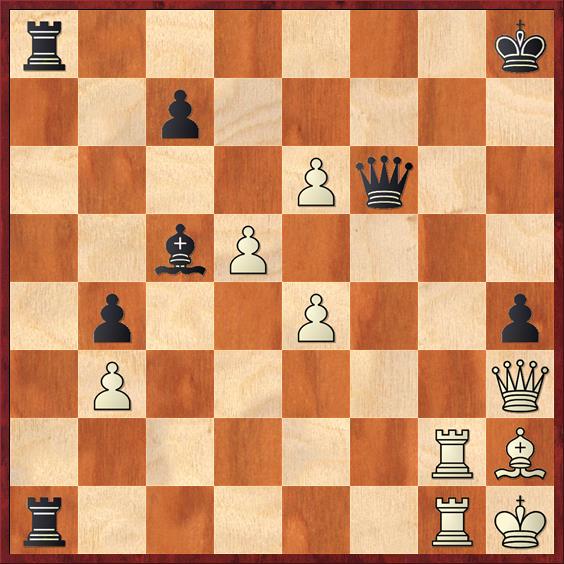
White to play and win!
49.Be5!! 1–0
We conclude with an interesting game by youth player Siem van Dael.
Van der Raaf - Van Dael
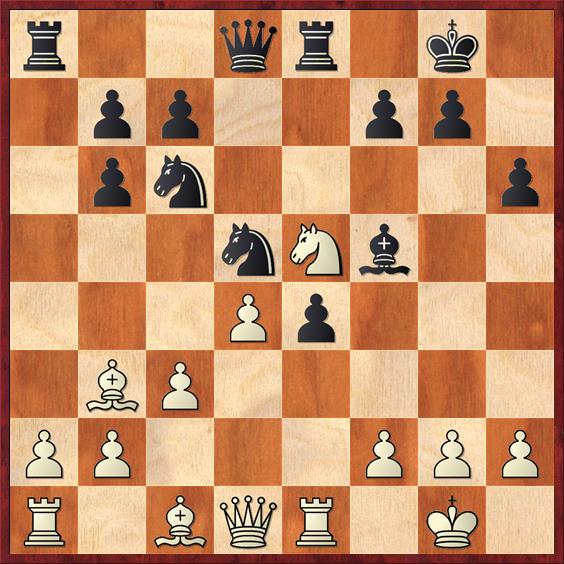
The white player went all out with:
15.Bxh6?! gxh6 16.Qh5 Rxe5
The computer gives 16...Be6 17.Ng4 Ra5 18.Nxh6+ Kg7, but this looks pretty risky. Black’s preference for the text move is quite understandable.
17.dxe5 Bg6 18.Qxh6 Nxe5 19.Rad1 Nd3

20.Re3?!
Again, quite ingenious (20...Nxe3?? 21.Qxg6+), but 20.f3! was the move that probably offered sufficient counterchances.
20...c6 21.Rg3 Qf6 22.Rf1
22.f3! would have kept White’s disadvantage within bounds.
22...N5f4 23.Rg4 Ra5!
Attack and defence at the same time. By the way, 23...e3 wasn’t to be sneezed at either.
24.g3 Ne2+ 25.Kg2 Qf3+ 26.Kh3
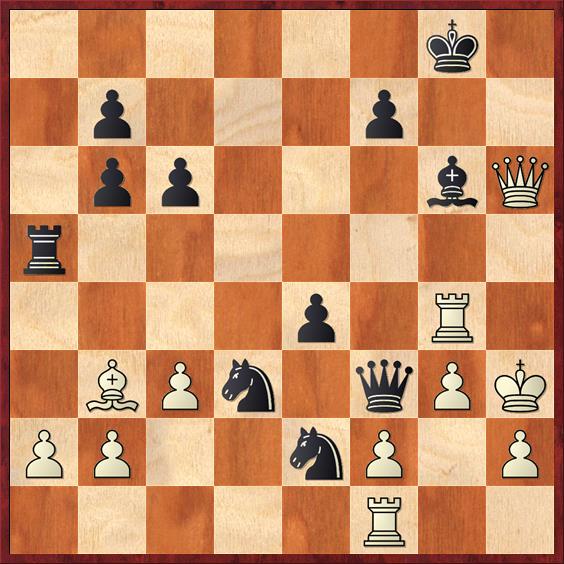
26...Ndf4+ 27.Rxf4 Nxf4+
And White resigned on account of mate in two.
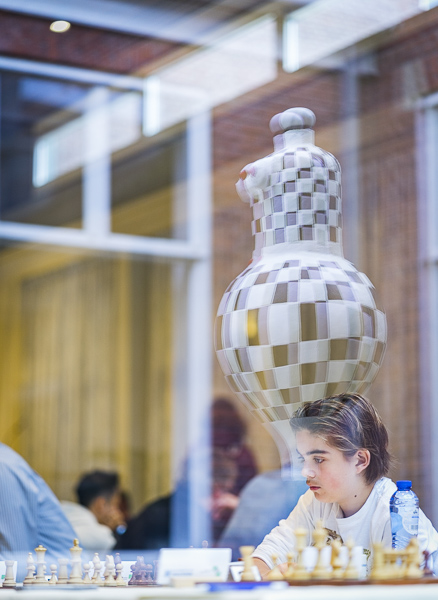
Siem van Dael. Foto: Lennart Ootes

 .
. 
